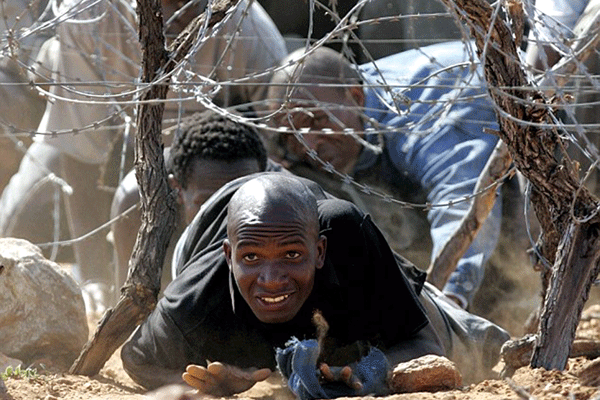Zimbabwe’s porous borders are proving to be the access gates for human traffickers and illegal migrants with the obtaining statistics indicating that the authorities are fighting a losing battle in trying to seal off its borders.
Zimbabwe Immigration department director Clemence Masango says many illegal immigrants are finding their way into the country through porous border post.
“Most illegal immigrants and human traffickers are using Zimbabwe as a transit to South Africa. We have reports that some are bribing corrupt immigration officers. Some of the officers have already been suspended,” he said.
In January this year, 34 Ethiopians immigrants were caught in Marondera enroute to Beitbridge. Among them were boys aged 11 and 12.
Another batch of 20 Ethiopians with no traveling documents were arrested in Gutu communal lands after a vehicle they were traveling broke down leading to their arrest in March this year.
In July 2016, a truck carrying 57 Malawian children was intercepted in South Africa after its driver and his two accomplices had successfully navigated their way through both the Mozambique and Zimbabwe border posts.
According to a statement issued by South Africa’s acting National Police Commissioner, Kgomotso Phahlane then, the cunning two traffickers aged 25 and 36, had initially refused to open the back of their truck when apprehended by the police.
The law enforcement agents then forcibly opened the truck‚ resulting in two children falling off the vehicle where they were stashed.
“This tells you that these children were being transported as if they were goats. They are now well looked after under the auspices of the Department of Social Development in the North West Province [as] these centres provide support and care in line with the Child Care Act. What boggles the mind is how the children passed through Zimbabwe and Mozambique borders all the way into South Africa under these conditions,” said Phahlane.
Political instability characterized by threats of war and acts of terror have resulted in thousands of nationals from Somalia, the Central Africa Republic and the Democratic Republic of Congo leaving their homelands and coming down to South Africa in search of greener pastures.
South Africa remains the final destination, whilst Zimbabwe is mostly considered as a transit point for refugees, drug traffickers and human traffickers as well on their sojourn to the promised land which is South Africa.
The 225 kilometer Zimbabwe- South Africa border stretch has provided a conducive haven for an array of commodities and contrabands which includes goods, drugs, arms, rhino horns and elephant tusks.
South African and Zimbabwean border patrol security have arbitrally failed to curb the illegal cross border transportation of contraband, at times becoming accomplices in these illicit deals.
South Africa based Africa Diaspora Forum director Marcus Gbaffou acknowledged that Zimbabwe was a transit point for human traffickers and illegal migrants.
“We deal with a lot of illegal migrants and human trafficking victims here in South Africa. Ironically, most of the people would have passed through Zimbabwe. To curb the vice, SADC should facilitate people’s free movement like in ECOWAS and the East African Community. This should extend the right of mobility to the people of DR Congo in the same way as it does for other citizens of the block,” he said.
The Zimbabwe government in 2014 passed the Trafficking in Persons (TiP) Act 10:20 into law, thus criminalizing the practice however, the problem still subsists.
Regardless of the signing of the act into law, illegal human trafficking cartels easily navigate their way through the country’s borders.
Vice President Emmerson Mnangagwa who doubles up as Justice and legal affairs Minister said that anybody who engages in human trafficking will face the full wrath of the law.
“As government our position is that anybody who engages in the trafficking of humans will be prosecuted. That is why we put the Trafficking in Persons Act into law.
We urge all stakeholders including the police to assist towards implementing TiP so that human trafficking won’t thrive in the country,” he said
Human trafficking is the second largest criminal trade in the world generating an estimated US$6-9 billion annually.
About 4 000 000 people are believed to be trafficked each year.
Between 1994 and 2013 the IOM assisted some 58 551 people from across the world with over 50 percent being women.
According to the United Nations Palermo Protocol of 2000, human trafficking refers to the transportation, transfer, harboring or receipt of persons by means of threats or use of force for purposes of exploitation
The Trafficking in Persons Act empowers the police and immigration officials to search, question and detain people entering or leaving Zimbabwe or seize property or assets of suspected persons where there exists a reasonable suspicion that the crime of trafficking in persons is being or is about to be committed.
It also provides for the establishment of centers for victims of trafficking in persons and for the programmes that might be offered to them as well as protection.
Source: 263 Chat

